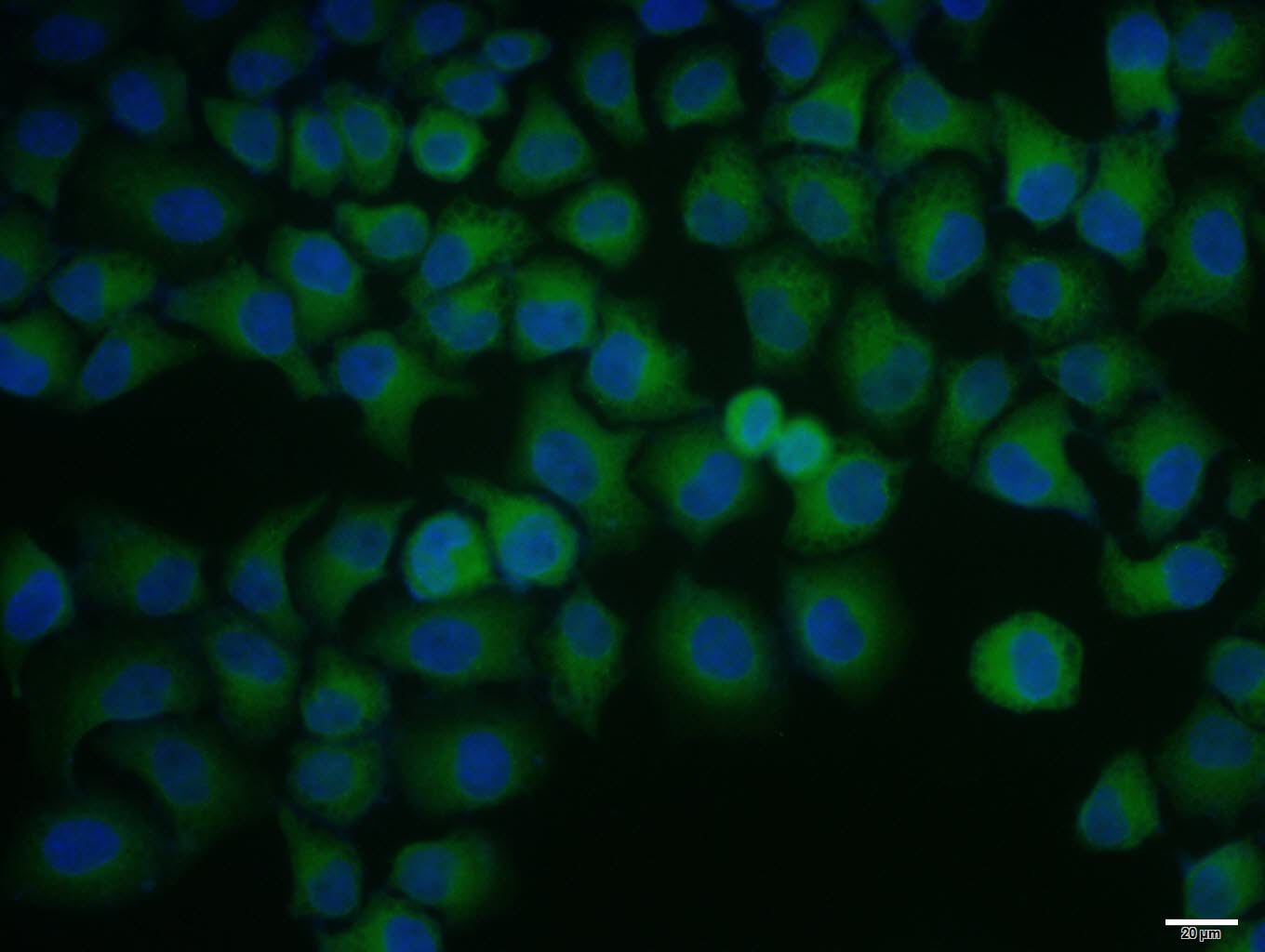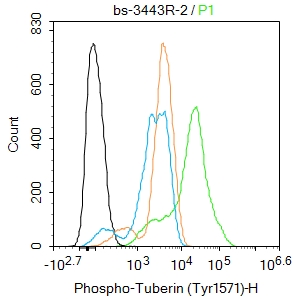
Rabbit Anti-Phospho-Tuberin (Tyr1571)antibody
Tuberin(phospho Y1571); Tuberin (phospho Tyr1571); p-Tuberin (Tyr1571); TSC2; FLJ43106; LAM; TSC2_HUMAN; TSC4; Tuberous sclerosis 2; Tuberous sclerosis 2 protein; Tuberous sclerosis 2 protein homolog.
View History [Clear]
Details
Product Name Phospho-Tuberin (Tyr1571) Chinese Name 磷酸化马铃薯球蛋白(结节性硬化)抗体 Alias Tuberin(phospho Y1571); Tuberin (phospho Tyr1571); p-Tuberin (Tyr1571); TSC2; FLJ43106; LAM; TSC2_HUMAN; TSC4; Tuberous sclerosis 2; Tuberous sclerosis 2 protein; Tuberous sclerosis 2 protein homolog. Product Type Phosphorylated anti Research Area Tumour immunology Signal transduction Immunogen Species Rabbit Clonality Polyclonal React Species Human, (predicted: Mouse, Rat, Chicken, Dog, Pig, Cow, Horse, Rabbit, ) Applications WB=1:500-2000 IHC-P=1:100-500 IHC-F=1:100-500 Flow-Cyt=2ug/Test ICC=1:100 IF=1:100-500 (Paraffin sections need antigen repair)
not yet tested in other applications.
optimal dilutions/concentrations should be determined by the end user.Theoretical molecular weight 180-220kDa Cellular localization cytoplasmic The cell membrane Form Liquid Concentration 1mg/ml immunogen KLH conjugated Synthesised phosphopeptide derived from human Tuberin around the phosphorylation site of Thr1571: R(p-Y)TE Lsotype IgG Purification affinity purified by Protein A Buffer Solution 0.01M TBS(pH7.4) with 1% BSA, 0.03% Proclin300 and 50% Glycerol. Storage Shipped at 4℃. Store at -20 °C for one year. Avoid repeated freeze/thaw cycles. Attention This product as supplied is intended for research use only, not for use in human, therapeutic or diagnostic applications. PubMed PubMed Product Detail Tuberin, or TSC2 (Tuberous sclerosis complex), is implicated as a tumor suppressor. It may function in vesicular transport, and may also play a role in the regulation of cell growth arrest and in the regulation of transcription mediated by steroid receptors. Interaction between hamartin (TSC1) and tuberin may facilitate vesicular docking. It specifically stimulates the intrinsic GTPase activity of the Ras related protein RAP1A and RAB5, suggesting a possible mechanism for its role in regulating cellular growth. Mutations in tuberin lead to constitutive activation of RAP1A in tumors. At least three isoforms of Tuberin exist.
Function:
In complex with TSC1, inhibits the nutrient-mediated or growth factor-stimulated phosphorylation of S6K1 and EIF4EBP1 by negatively regulating mTORC1 signaling. Acts as a GTPase-activating protein (GAP) for the small GTPase RHEB, a direct activator of the protein kinase activity of mTORC1. Implicated as a tumor suppressor. Involved in microtubule-mediated protein transport, but this seems to be due to unregulated mTOR signaling. Stimulates weakly the intrinsic GTPase activity of the Ras-related proteins RAP1A and RAB5 in vitro. Mutations in TSC2 lead to constitutive activation of RAP1A in tumors.
Subunit:
Interacts with TSC1 and HERC1; the interaction with TSC1 stabilizes TSC2 and prevents the interaction with HERC1. May also interact with the adapter molecule RABEP1. The final complex contains TSC2 and RABEP1 linked to RAB5 (Probable). Interacts with HSPA1 and HSPA8. Interacts with DAPK1.
Subcellular Location:
Cytoplasm. Membrane; Peripheral membrane protein. Note=At steady state found in association with membranes.
Tissue Specificity:
Liver, brain, heart, lymphocytes, fibroblasts, biliary epithelium, pancreas, skeletal muscle, kidney, lung and placenta.
Post-translational modifications:
Phosphorylation at Ser-1387, Ser-1418 or Ser-1420 does not affect interaction with TSC1. Phosphorylation at Ser-939 and Thr-1462 by PKB/AKT1 is induced by growth factor stimulation. Phosphorylation by AMPK activates it and leads to negatively regulates the mTORC1 complex. Phosphorylated at Ser-1798 by RPS6KA1; phosphorylation inhibits TSC2 ability to suppress mTORC1 signaling. Phosphorylated by DAPK1.
DISEASE:
Defects in TSC2 are the cause of tuberous sclerosis type 2 (TSC2) [MIM:613254]. TSC2 is an autosomal dominant multi-system disorder that affects especially the brain, kidneys, heart, and skin. It is characterized by hamartomas (benign overgrowths predominantly of a cell or tissue type that occurs normally in the organ) and hamartias (developmental abnormalities of tissue combination). Clinical symptoms can range from benign hypopigmented macules of the skin to profound mental retardation with intractable seizures to premature death from a variety of disease-associated causes.
Defects in TSC2 are a cause of lymphangioleiomyomatosis (LAM) [MIM:606690]. LAM is a progressive and often fatal lung disease characterized by a diffuse proliferation of abnormal smooth muscle cells in the lungs. It affects almost exclusively young women and can occur as an isolated disorder or in association with tuberous sclerosis complex.
Similarity:
Contains 1 Rap-GAP domain.
SWISS:
P49815
Gene ID:
7249
Database links:Entrez Gene: 7249 Human
Entrez Gene: 22084 Mouse
Omim: 191092 Human
SwissProt: P49815 Human
SwissProt: Q61037 Mouse
Unigene: 90303 Human
Unigene: 30435 Mouse
Unigene: 5875 Rat
Tuberin 为180kD-220的蛋白产生于结节性硬化(TSC-2)位于染色体16的基因。结节性硬化为常染色体疾病已知为斑痣性错构瘤病其特征为广泛性发展呈良性生长,在许多组织与器官中描述为错构瘤。Tuberin被认为在GTPase活动性蛋白中起作用调节细胞内吞与作为Tumour抑制子。Tuberin低水平广泛性表达在大多数组织中,而在皮层神经元、小脑浦肯野氏细胞、脊索运动神经元、胰岛B细胞、心肌、肾脏与皮肤的小血管中表达增加。Product Picture
Primary Antibody (green line): Rabbit Anti-Phospho-Tuberin (Tyr1571) antibody (SL3443R)
Dilution:2ug/Test;
Secondary Antibody(white blue line): Goat anti-rabbit IgG-AF488
Dilution: 0.5ug/Test.
Isotype control(orange line): Normal Rabbit IgG
Protocol
The cells were fixed with 4% PFA (10min at room temperature)and then permeabilized with 90% ice-cold methanol for 20 min at -20℃, The cells were then incubated in 5%BSA to block non-specific protein-protein interactions for 30 min at room temperature .Cells stained with Primary Antibody for 30 min at room temperature. The secondary antibody used for 40 min at room temperature. Acquisition of 20,000 events was performed.
Bought notes(bought amounts latest0)
No one bought this product
User Comment(Total0User Comment Num)
- No comment




 +86 571 56623320
+86 571 56623320
 +86 18668110335
+86 18668110335

